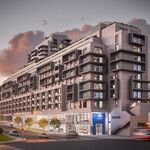Juan_Lennon416
Senior Member
Very sad to watch Miller spend over 15 billions on streetcars.... What a freakin waste
Tell it to his face...not on here
Very sad to watch Miller spend over 15 billions on streetcars.... What a freakin waste
LAz does not believe that LRT will work in Toronto. Does that mean it's a bad idea? NO.
I do not oppose LRT on some places. I do oppose it on certain places.
I strongly distrust any claims that LRT west of eglinton's tunnel will be one km slower than in the tunnel. That is just ridiculous. Above ground LRT is always significantly slower than underground LRT - unless if it is completely separate. Just think about it - how can it make sense that it is only 1 km/h slower? How? That's ridiculous.
We have seen reports earlier that the speed will be 22km/h. I will accept that number.
We also see that the TTC and Toronto do not want to talk about the speed. I posted the report/information thing from november or december of 2009... they go into just about every detail they can think of - but they do not talk about speed. That's on purpose.
Do you think we're all small children? We all know that the 501 is slow and unreliable, and we all know it doesn't have any relevance to the LRT lines being discussed here.
Why don't you bring up examples of unreliable and slow bus services and say "see, all buses are therefore slow, even BRT"?
The Toronto subway's importance to the city's daily operations are exactly why more subway lines are needed. Toronto has enough demand for the length of the subway system to be doubled, at least.I also find your obsession with length to be silly. DC might have a longer subway network, but it's used by fewer people than TTC, and is a lot less important to the citys daily operations. We could build a subway which nobody wants needs or uses, and that would move us up in the length department but doesn't make the city any better.
With proper station spacing, all-door boarding, and complete traffic priority, trams can be just as fast as subway. They don't even have to be totally grade separated, as the Edmonton and Calgary systems show. The Transit City lines might not be designed that way, but that doesn't mean it's not possible.Trams are slower. Period. No debate here. It's a fact.
Sheppard LRT: $63 million per km. Spadina Subway is $302 million per km. Even if you cut that in half, you're still more than double the LRT cost.
It will be tunnelled under Eglinton. That makes it a subway in my opinion. If you want to debate semantics then feel free.
The airport is getting a heavy rail connection: Union Pearson Air Rail Link. Again, feel free to debate semantics.
Monterrey, Boston, Calgary, Guadalajara, San Francisco, Los Angeles, Portland, Philadelphia, San Diego, Mexico City, Dallas, Denver, Newark, Saint Louis, Sacramento, Salt Lake City, Baltimore, Phoenix, Edmonton, San Jose, Minneapolis, Houston, Pittsburgh, Buffalo, Charlotte, Seattle, New Orleans, Ottawa, Cleveland, Oceanside, Memphis, Seattle & Tampa *must* all be tiny towns masquerading as big cities. Either that or you need to start making some phone calls to tell planners in these cities that they're stupid.
A lot of people are calling Transit City 'Transfer City'. Making tranfers from bus to streetcar or subway or future LRT is part of taking public transit. I am originally from Montreal, lived most of my life in Vancouver (where I got hooked on public transit) and now live in Toronto. Making tranfers is one of the really well put together parts of this system at a lot of the stations. Like I said I lived most of my life in Vancouver and it was one thing about the design of the TTC that impressed me is that a lot of the times the buses enter right into the stations themselves. This didn't happen too often in the other cities I have lived in and visited.
It is comfortable to wait for your connecting bus indoors when the weather is not so ageeable. More stations are being designed this way as well. We live near Warden Station so I use that station most, the bus routes into the station are great but the seperate bus bays are not so comfortable or convenient. Victoria Park Station is going to be designed with a shared platform for all the different bus routes and we commuters are going to have an indoor area to wait for our connecting bus.
Now only if the TTC would expand a bit more. I see that it is a little more expensive here though with the thought and convenience put into the station designs.
It is true that fewer people will fly.
However, currently the percentage of air passengers taking public transit to Pearson is very low: I heard about 3%, although I don't have a link.
With a good transit link in place, that percentage can grow so much that it overweights the decline in air traffic. So, fewer people fly and fewer people drive to the airport, but more people take public transit there.
It's a false dichotomy. Both will likely be built. Unfortunately the best option, a publicly run regional rail line along the Weston sub with several stations on the way downtown, isn't even being talked about. That line would have all the benefits of the Eglinton LRT plus a one-seat ride downtown, the single biggest destination for airport travellers.The beauty of an Eglinton Line opposed to Union Pearson AirLink is that you not only net in downtown travellers, but also those from Midtown, Scarborough, North York, Etobicoke and especially Greater Mississauga via the ACC stn. Larger market share.
It has every bit of relevancy because both the downtown streetcar lines and these new suburban Transit City lines will be owned and operated by the same transit agency. If route mismanagement is commonplace for one mode, it can be for them all. If transit signal priority is lacking on key routes through busy intersections in one part of the city, the same mistakes can be replicated the whole city over. The theoretical operational speeds placed in a self-serving Powerpoint presentation to manipulate the public; and the preexisting track record of subpar service the TTC is notorious for in regards to its light rail fleet are two entirely different things.
While it's true that the LRT lines will be owned by Metrolinx, it's not clear how much of a day-to-day role Metrolinx will play. I certainly hope that they play a positive role, but there is no certainty of that.Wrong. The LRT lines and vehicles will be owned by Metrolinx, not TTC. Metrolinx will have a stronger influence on city departments such as traffic, than TTC currently does.
While it's true that the LRT lines will be owned by Metrolinx, it's not clear how much of a day-to-day role Metrolinx will play. I certainly hope that they play a positive role, but there is no certainty of that.
Does that mean we will see a different logo on these trams.
Sorry, but if the TTC is not calling it a subway (and they're not), neither am I.It will be tunnelled under Eglinton. That makes it a subway in my opinion. If you want to debate semantics then feel free.




